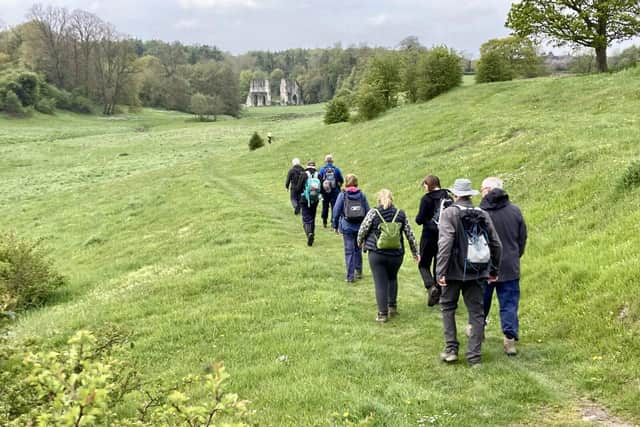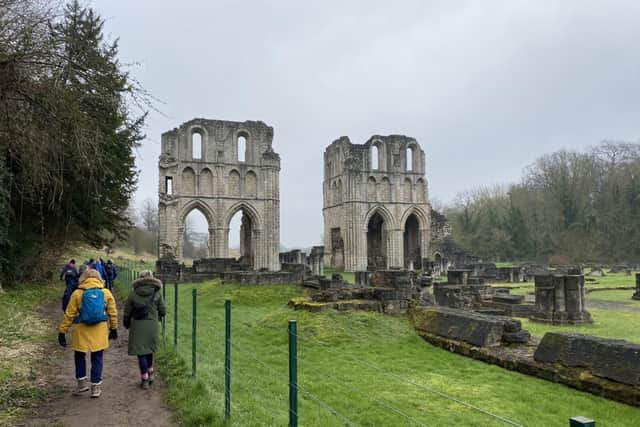Doncaster Ramblers: Roche Abbey Round
and live on Freeview channel 276
The abbey was founded in 1147, one of the founders being Roger de Busli, probably the great-nephew of Roger de Busli, the builder of Tickhill castle. The founding monks came south from Newminster Abbey in Northumberland. The monastery at Roche originally comprised a walled precinct containing a series of buildings and enclosures, with the church and cloister at the centre. Today the only structures standing to any height are the transepts and presbytery of the church, begun in the 1170s, and the great gatehouse.
After a short walk from the car park we came to the Great Gatehouse. It was re-built in about 1300, a two-storey building of which only the lower storey remains. From the west-facing porch the monks dispensed food to the destitute, and from the east-facing gate hall they admitted guests and monitored entries and exits. Between the two were gates, the larger for carts, the smaller for pedestrians.
Advertisement
Hide AdAdvertisement
Hide AdUnusually for a Cistercian building, in which figurative sculpture was prohibited, the vault springers are decorated with carved heads. Traces of the original plaster and painted detailing of the vaulting remain. Much of the pavement is medieval. A large room over the porch and hall, with benching around the outer walls, was probably used for court hearings to settle legal disputes with tenant landowners. Three smaller rooms built into the rock outcrops were used as accommodation for the gatekeeper and to store records.


The valley’s terrain and the intersection of two abundant water supplies – Maltby Dike and Hooten Dike – determined where the monks set out their buildings. At the monastery’s peak, the community of about one-hundred and fifty men was composed of one-third monks and two-thirds lay brothers, and each group required a separate set of buildings including a dormitory, day room, refectory, two-storey latrine block and infirmary.
From the Abbey we entered King's Wood, passing Laughten Pond and then gradually ascending until we reached a lovely path along the edge of a scarp slope, with views across undulating land towards Maltby and Thurcroft. This path took us towards Laughten en le Morthen, with the magificent spire of All Saints Church clearly visible. A couple of left turns took us the the Laughten village hall, where we enjoyed our refreshments on seats by the children's recreation area.
Leaving Laughten we walked a short distance before turning left at St John's Farmhouse and along the airy track of Kirk Croft Road. After about thirty minutes we reached Long Thwaite wood, with its scorched trees from the crop fires of a few years ago.
Advertisement
Hide AdAdvertisement
Hide AdAt some cottages we turned briefly right and then left and onto a minor road which took us into Firbeck. Directly alongside St Martin's church we turned onto a footpath, which immediately took us the the memorial, unveiled in 2011, marking the site of the former RAF Firbeck.


The light aerodrome previously in existence was requisitioned by the Air Ministry in 1940 and became the base for the 613 Squadron. From here we followed tracks and cross-field paths to the tiny hamlet of Stone where, at a former mill, we turned left for two-hundred yards, climbing a high stile or passing through a narrow gate, crossing a field, climbing another stile before reaching the field with the magnificent site of Roche Abbey to mark the end of the walk.
Thanks to Tony F for efficient back-marking.
Non-members welcome, just turn up and say “Hallo” you will be well looked after
Please visit our website www.doncasterramblers.org.uk/ for latest information, including future activity
Remember while out observe the Countryside Code and give way to other walkers.